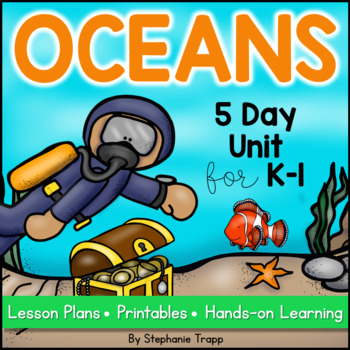Ocean Unit for Kindergarten and First Grade
- PDF
What educators are saying
Description
Why is the ocean salty? How do fish breathe underwater? Learn the answers to these questions and MORE during this ocean unit for kindergarten and first grade! The week-long comprehensive unit includes detailed daily lesson plans with literature suggestions. It incorporates science, reading, writing, math, handwriting and art. It also includes QR codes and links to videos that complement the unit study.
Click on the PREVIEW to read each lesson plan, see the Week-at-a-Glance planning sheet, as well as examples of printables and art projects.
Teacher Features You’ll Love
- Detailed daily lesson plans
- Week-at-a-glance planning guide
- Guide for stretching the unit over two weeks
- Key concepts and objectives
- Extensive literature list
- Video links and QR codes
- Differentiated versions of math sheets
- Activity directions and printable templates
What’s Covered in the Unit?
Day 1: What is an Ocean?
- Five Oceans Song
- Salt Water Experiment
Day 2: How Deep is the Ocean?
- Ocean Zones Water Bottle Activity
Day 3: What are Coral Reefs?
- Coral Reef Art Project
- Build a Coral Reef Play Doh Mat
Day 4: How Do Fish Breathe in the Ocean?
- How Fish Breathe Experiment
- Fish Report
Day 5: How Can We Protect the Ocean?
- Recycled Art Project or STEAM Challenge
Math Connections
- Math game for a math center
- Counting within 10, 20 and 100
- Tally marks
- Finding one more/less
- Comparing numbers: larger/smaller and with >, <, =
- Place value: tens and ones, counting base ten pieces
- Addition with a number line within 10 and 20
- Addition and subtraction within 10, 20 and 100
- Missing numbers in addition and subtraction
- Making addition and subtraction sentences
- Time to the hour and half hour
- Graphing
- Drawing 2D shapes
- Measuring with nonstandard units
- Word problems
Literacy Connections
- Ocean word wall
- “Dan’s Big Dive” emergent reader
- Beginning letter sounds
- Long vowel O
- CVC focus word: fin
- Medial vowels in CVC words
- Vowel teams -ea (sea) and -ee (reef)
- Rhyming
- Sight word story
- Action verbs
- Correcting mixed up sentences
- Fish report writing
- Ocean acrostic poem
- Ocean Adventure writing activity
- All About Oceans expository writing activity
- Would You Rather…? opinion writing activity
Please note: This unit doesn’t focus on learning a lot about specific ocean animals. If you need a unit like that, hang on. It’s coming! I’m currently working on a unit about ten ocean animals that I hope to have finished soon.
Questions? Feel free to email me at primarythemepark@gmail.com.
Find more cross-curricular units for K-1 HERE!
Thanks so much for stopping by!





